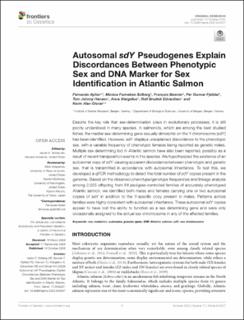Autosomal sdY pseudogenes explain discordances between phenotypic sex and DNA marker for sex identification in Atlantic salmon
Ayllon, Fernando; Solberg, Monica Favnebøe; Besnier, Francois; Fjelldal, Per Gunnar; Hansen, Tom Johnny; Wargelius, Anna; Edvardsen, Rolf Brudvik; Glover, Kevin
Peer reviewed, Journal article
Published version
Permanent lenke
https://hdl.handle.net/11250/2688503Utgivelsesdato
2020Metadata
Vis full innførselSamlinger
- Articles [3012]
- Publikasjoner fra CRIStin [3070]
Sammendrag
Despite the key role that sex-determination plays in evolutionary processes, it is still poorly understood in many species. In salmonids, which are among the best studied fishes, the master sex-determining gene sexually dimorphic on the Y-chromosome (sdY) has been identified. However, sdY displays unexplained discordance to the phenotypic sex, with a variable frequency of phenotypic females being reported as genetic males. Multiple sex determining loci in Atlantic salmon have also been reported, possibly as a result of recent transposition events in this species. We hypothesized the existence of an autosomal copy of sdY, causing apparent discordance between phenotypic and genetic sex, that is transmitted in accordance with autosomal inheritance. To test this, we developed a qPCR methodology to detect the total number of sdY copies present in the genome. Based on the observed phenotype/genotype frequencies and linkage analysis among 2,025 offspring from 64 pedigree-controlled families of accurately phenotyped Atlantic salmon, we identified both males and females carrying one or two autosomal copies of sdY in addition to the Y-specific copy present in males. Patterns across families were highly consistent with autosomal inheritance. These autosomal sdY copies appear to have lost the ability to function as a sex determining gene and were only occasionally assigned to the actual sex chromosome in any of the affected families.
